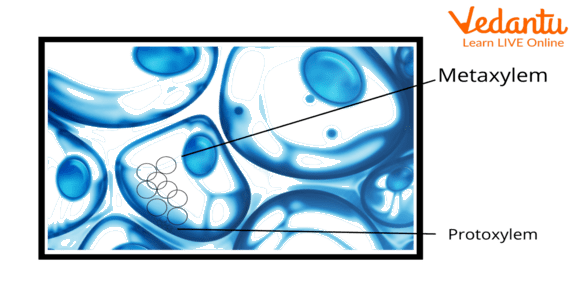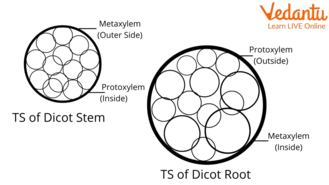An Introduction to Protoxylem and Metaxylem
Xylem is a water-conducting vascular tissue, which helps in the upward movement of water and minerals from roots to other parts of the plant. The xylem tissue consists of four elements – tracheids, xylem parenchyma, vessel elements and fibres. The vascular tissue undergoes primary and secondary growth.
The procambium provides the xylem with protoxylem and metaxylem during primary growth. One of the two categories of vascular tissues in plants is the xylem. Primary and secondary xylems are two different types of xylems. The primary xylem develops during primary growth.
Protoxylem and metaxylem are the two components of primary xylem. Protoxylem is formed before the plant organs complete their elongation while metaxylem formed later after primary xylem matures, once completion of the growth of the plant organs. The protoxylem has smaller cells and metaxylem contains larger cells.
What is Protoxylem and Metaxylem?
Two primary xylem kinds that emerged during the primary growth of vascular plants are protoxylem and metaxylem. Metaxylem is the later created primary xylem that matures after the expansion of the plant organs, whereas protoxylem is the first formed primary xylem that matures before the plant organs finish their elongation. Protoxylem also contains smaller cells.
The metaxylem, however, has bigger cells. Additionally, protoxylem has a limited amount of lignification, which makes it less effective in conducting water. Due to its increased lignification, the metaxylem is very effective at conducting water. This encapsulates how protoxylem and metaxylem differ from one another.
Protoxylem
Proto means ‘first’ and Xylem means ‘wood’; the first primary xylem
The primary xylem that forms initially during primary growth is called the protoxylem.
Prior to plant organ elongation, protoxylem develops.
Protoxylem is found toward the outside of a stem.
It comprises more compact cells.
In other words, it has tracheids and components of thin vessels. As a result, the cells' lumen is small.
In the protoxylem cells, lignification is also not very extensive.
The secondary cell walls of protoxylem vessels exhibit annular and spiral thickenings.
Additionally, protoxylem lacks xylem fibres and has a significant quantity of parenchyma.
Protoxylem is less effective in conducting water than metaxylem.
Metaxylem
Meta means ‘last’ and Xylem means ‘wood’; the last primary xylem.
The primary xylem's metaxylem is the portion that forms the following protoxylem.
After the plant organs have finished growing, the metaxylem develops.
It can be found near the stem's interior.
Larger cells like tracheids and broader arteries are found in metaxylem.
The lignification of metaxylem cells is also quite widespread.
The secondary cell walls of metaxylem vessels have scalariform, reticulate, and pitted thickenings.
Metaxylem also has a small amount of parenchyma cells and xylem fibres. Protoxylem is less effective than metaxylem for conducting water and minerals.
Therefore, compared to the lumen of protoxylem cells, the lumen of cells is bigger.
Protoxylem and Metaxylem Difference
The distinctions between protoxylem and metaxylem is provided in the table below.
Similarities Between Protoxylem and Metaxylem
Protoxylem and Metaxylem in Stem
The stem bears conspicuous nodes and internodes.
In the stem, primary xylem and phloem lie side by side in the same radius i.e. they are conjoint collateral.
The xylem of the stem is Exarch, Endarch or Mesarch.
The exarch condition is more common in present day plants.
Protoxylem and Metaxylem Diagram

T. S. Showing Protoxylem and Metaxylem

T. S. of Stem and Roots Showing Protoxylem and Metaxylem
Protoxylem and Metaxylem in Root
Roots are Generally of Two Types: primary roots which originate from embryo and adventitious roots which arise secondarily from stem, leaf or other tissue.
In roots, the strand of primary xylem and phloem lies in different radii, separate from one another.
The xylem of the root is always in exarch condition.
Interesting Facts
As metaxylem is formed after protoxylem, it is more mature than protoxylem. metaxylem is a differentiated part of protoxylem.
Protoxylem has deposition of lignin in the form of rings in an annular pattern.
Important Questions
1. How to identify protoxylem?
2. Name the two main groups in which secondary xylem can be found.
Key Features
Two primary xylem kinds that conduct water and minerals are protoxylem and metaxylem.
In vascular plants, they exist.
Additionally, both are created throughout a plant's primary development.
Additionally, both come from procambium.
Protoxylem and metaxylem both include both living and dead cells.


FAQs on Protoxylem and Metaxylem
1. What is the main difference between protoxylem and metaxylem?
The main difference lies in their development and structure. Protoxylem is the first part of the primary xylem to form and has narrower vessels. Metaxylem develops later, after the plant part has grown, and has much wider vessels for more efficient water transport.
2. How are protoxylem and metaxylem arranged in plant stems and roots?
The arrangement differs based on the plant part:
- In stems, the arrangement is typically endarch, where the protoxylem is located towards the centre (pith) and the metaxylem is towards the periphery.
- In roots, the arrangement is exarch, with the protoxylem on the periphery and the metaxylem towards the centre.
3. What are the primary functions of protoxylem and metaxylem?
Both are responsible for conducting water and minerals from the roots to the rest of the plant. However, protoxylem serves the young, growing regions, while metaxylem provides the main structural support and water transport for mature, fully grown plant parts.
4. Which is considered more mature, protoxylem or metaxylem, and why?
Metaxylem is considered more mature. It forms after the primary growth (elongation) of a plant part is complete. Its cells are larger, more lignified, and more efficient at water conduction compared to the earlier-formed protoxylem.
5. What does the term 'exarch' mean in the context of xylem?
An exarch arrangement means that the development of xylem begins from the outermost cells and proceeds inwards. In this case, the protoxylem is found on the periphery (outside), and the metaxylem is located at the core (centre). This is a characteristic feature of plant roots.
6. Why does protoxylem have narrower vessels than metaxylem?
Protoxylem forms in plant parts that are still actively elongating. Its vessels are narrower and have flexible, ring-like (annular) or spiral lignin thickenings. This structure allows the vessels to stretch and grow along with the organ without breaking. Metaxylem forms after elongation has stopped, so it can develop wider, more rigid vessels for maximum water flow.
7. How does the arrangement of xylem (endarch vs. exarch) relate to the function of a stem versus a root?
The arrangement is directly related to function and growth. The endarch pattern in stems allows them to grow in width and support branches without disrupting the central water-conducting tissues. The exarch pattern in roots is ideal for absorbing water, as the vascular tissue differentiates from the outside layer (pericycle) inwards, establishing a direct path to the central vascular cylinder.
8. What is a 'mesarch' arrangement and how is it different from endarch and exarch?
Mesarch is an intermediate arrangement where the protoxylem is located in the middle of a strand of metaxylem, meaning development proceeds both inwards and outwards. It is different from endarch (outward development) and exarch (inward development). This arrangement is commonly found in the leaves and stems of ferns.










